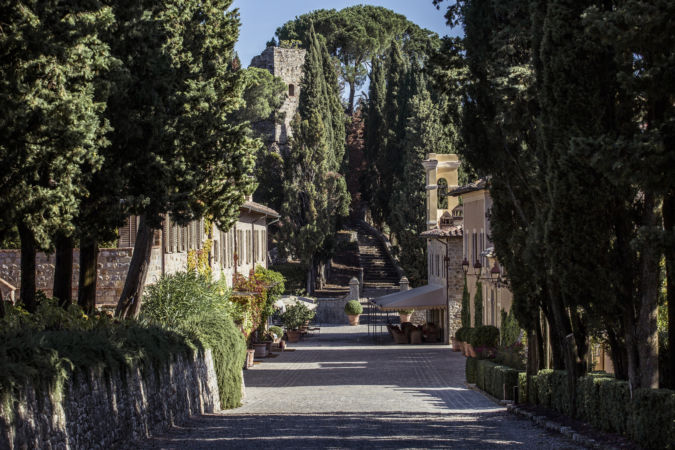
Wine
Castiglion del Bosco: paradise regained
Words by Adam Lechmere and Kelly Ervin
Photography by Charlie Dailey
Massimo Ferragamo went to Tuscany in 2003 on the lookout for a modest Brunello vineyard. He ended up buying a town. It was as much of a surprise to him as it was to everyone else – “a moment of weakness”, he now says. A friend was showing him around, and they visited the Capanna vineyard, a particularly fine slate hillside, certified Brunello di Montalcino and part of the Castiglion del Bosco estate.
“I looked at it with curiosity but not with interest,” the youngest son of Salvatore Ferragamo, founder of the luxury international shoe-to-leather-goods empire, adds. “I wanted eight to 10 hectares, and this was nearly 60 and came with 1,800ha of land. It wasn’t for me.”
Less than a year later he found himself the owner of a deserted feudal town. Castiglion del Bosco comprised the ruined castle dating from 1100, twenty farms and their attendant buildings, a police station and – the jewel in the crown – the 14th-century chapel of San Michele Arcangelo, with its 1345 mural by Pietro Lorenzetti.
Today, the azure blue of a swimming pool shimmers on a terrace overlooking the vast Tuscan landscape, and a Tom Weiskopf-designed golf course is a rolling expanse of green against the tawny browns of the Tuscan hills; there’s the winery, a 23-room hotel, two restaurants, a spa and 11 villas – one of which used to be the police station.
“Sometimes I have a feeling for what is right,” Ferragamo says. “I don’t want to say ‘vision’, because I admire people who have vision and I don’t know if I have it. My skill, maybe, is to see the whole ensemble. When I first looked at Castiglion del Bosco, I saw it as it is today.”
The beauty of Tuscany always makes you catch your breath. Looking out over the Capanna vineyard and the Castiglion estate (its borders seem infinitely far in the hazy summer heat), Ferragamo’s decision seems perfectly logical. What other response could there be to such a landscape, than an urge to possess it and cherish it?

High above Montalcino and bordered by cypresses, Castiglion del Bosco is timeless Tuscany

Massimo Ferragamo displays “the easy confidence of the youngest of the family,” said Lechmere, in his original story

The azure blue of the pool shimmers in the September sun, with the restored borgo, previously the centre of the community and now the main hotel building, behind. The key, Ferragamo says, is authenticity. ‘You don’t want to restore anything too much.’

As well as vegetables, fruits and herbs – and wine and grappa – the estate provides executive chef Marco Matteo Temperini with honey and olive oil, fresh vegetables, and Tuscan cold cuts and game from the farm.

Castiglion del Bosco sits high and remote in the hills – here, morning mists roll up from the Val d’Orcia

The main avenue of the estate leads to the 14th-century chapel of San Michele Arcangelo, its bell tower visible on the right

When a wall of the borgo needed to be rebuilt, the old stones were numbered as it was dismantled, so that each could be put back in its original position. “Almost all the materials we use are from here,” Ferragamo says.

Chiara Ferragamo is in charge of the smallest detail of interior design, from the parquet on the floors to the table linen. “I have to think, ‘Does that plate work with that cloth?'”

The Capanna vineyard is planted to Sangiovese, with Ferragamo’s ambition to produce world-class Brunello. “The first thing I checked before I bought it was whether you could make one of the best Brunellos in the region.”


Winemaker Cecilia Leoneschi. “I have no patience with people who say they won’t produce Brunello in a mediocre year. You have to recognise the vintage; you have to witness it.”

Above the altar in the chapel of San Michele Arcangelo is the 1345 mural by Pietro Lorenzetti. The chapel’s roof had caved in and had to be rebuilt, but the fresco had escaped damage


The trattoria, next door to the chapel, was the priest’s house – his bread oven is now used for wood-fired pizza. His garden, meanwhile, is now the dining room – the old oak has been left untouched

In a former life its job was to guard the entrance to the estate; now the old castle tower looks as if it’s chaperoned by cypresses and Italian oaks

Because the estate is in the middle of the UNESCO World Heritage Site of Val d’Orcia, the bunkers on the golf course have to be filled with dark sand, not white, to avoid too jarring a contrast with the hillsides

The northern approach to Castiglion del Bosco is along one of the strade bianche, the famous unfinished white roads of this part of Tuscany. It’s notably democratic – Porsches and hired Fiats alike have to navigate the potholes.

Massimo with Chiara Ferragamo. “You can destroy things that are centuries old by renovation. I remember seeing it in ruins, and seeing its character, and I said to the team of designers and architects, ‘When we are finished, it has to look exactly the way it does today.'”



